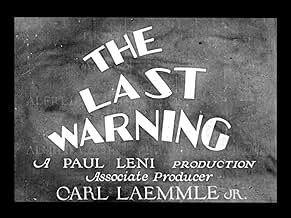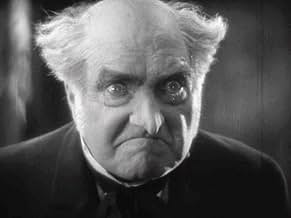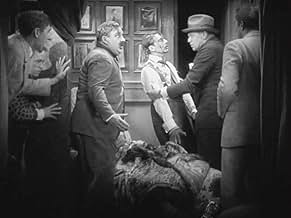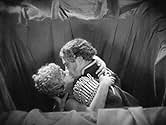Agrega una trama en tu idiomaA producer decides to reopen a theater, that had been closed five years previously when one of the actors was murdered during a performance, by staging a production of the same play with the... Leer todoA producer decides to reopen a theater, that had been closed five years previously when one of the actors was murdered during a performance, by staging a production of the same play with the remaining members of the original cast.A producer decides to reopen a theater, that had been closed five years previously when one of the actors was murdered during a performance, by staging a production of the same play with the remaining members of the original cast.
- Dirección
- Guionistas
- Elenco
Carrie Daumery
- Barbara Morgan
- (as Mme. Carrie Daumery)
Slim Summerville
- Tommy Wall
- (as 'Slim' Summerville)
Bud Phelps
- Sammy
- (as 'Buddy' Phelps)
Charles K. French
- Doctor
- (sin créditos)
Pat Harmon
- Cop
- (sin créditos)
Francisco Marán
- Jeffries
- (sin créditos)
Opiniones destacadas
THE STORY & (Pseudo)GENRE -- PHANTOM OF THE OPERA meets CAT AND THE CANARY (also by director Leni). Bizarre visuals liven up the nonsense.
THE VERDICT -- Fast-paced even at 78 minutes. Plenty of old-time thrills and smiles.
FREE ONLINE -- Yes. The ubiquitous orange-tinted print (77 minutes), but also the newer BD upgrade (78 minutes), can be found. Silent with music and effects. I have never seen an 89-minute version, as advertised by IMDB.
THE VERDICT -- Fast-paced even at 78 minutes. Plenty of old-time thrills and smiles.
FREE ONLINE -- Yes. The ubiquitous orange-tinted print (77 minutes), but also the newer BD upgrade (78 minutes), can be found. Silent with music and effects. I have never seen an 89-minute version, as advertised by IMDB.
This movie pops up on ebay once in a while and for fans of mystery or horror films, particularly those of Universal, this is a must.
The plot is unimportant - it is about a haunted old theater where an old Broadway play is being brought back despite threats from the ghost of a dead actor.
This film was the last directed by the great Paul Leni. It is really the work of a virtuoso working at his peak. It has everything The Cat and the Canary had and more. The version that seems to be relatively available on video has a good music track too, but unfortunately it seems that the experimental sound sequences the film originally contained have not survived.
Nevertheless, we are lucky that this film has survived as it is such a joyous romp of horror cliches with inventive, wild camera moves and stunning lighting and spooky set design. It foreshadows the great horror classics that were less than two years away for Universal. It is just wonderful filmmaking from a forgotten great director who was at his peak, so if you are into old dark house mysteries or Universal horror movies - FIND IT! - It is one of the best!
8/10 - even better than The Cat and the Canary.
The plot is unimportant - it is about a haunted old theater where an old Broadway play is being brought back despite threats from the ghost of a dead actor.
This film was the last directed by the great Paul Leni. It is really the work of a virtuoso working at his peak. It has everything The Cat and the Canary had and more. The version that seems to be relatively available on video has a good music track too, but unfortunately it seems that the experimental sound sequences the film originally contained have not survived.
Nevertheless, we are lucky that this film has survived as it is such a joyous romp of horror cliches with inventive, wild camera moves and stunning lighting and spooky set design. It foreshadows the great horror classics that were less than two years away for Universal. It is just wonderful filmmaking from a forgotten great director who was at his peak, so if you are into old dark house mysteries or Universal horror movies - FIND IT! - It is one of the best!
8/10 - even better than The Cat and the Canary.
This dazzling example of late silent cinema was available only in shoddy, awful looking prints for 80 years or more, until it was restored in 2016 and finally released on home video in 2019, and now for the most part looks fantastic. It was the final film made by the great Paul Leni, whose magnificent "The Man Who Laughs" is one of the absolutely essential silent works everyone needs to see at least once before they die.
The story of this one is a cross between The Cat And The Canary and The Phantom of The Opera, but not really as good as either: an actor is killed onstage and everyone in the cast and crew becomes a suspect; the theatre closes for years until the play is revived, and the killer plans to kill all over again. There's secret passageways and cobwebs galore, and a decent enough mystery, but it's got to be said the plot's a little messy and hard to follow at times.
It's in the visuals that The Last Warning really shines, with the camera in every scene swooping and zooming in on every action taking place, and great use of depth of field to draw one's eyes to things happening in the background: the camera is always doing something, always telling us something about the story and the characters, purely through visual means. This is the very peak of what silent cinema was reaching for at the end of the 1920s, just before the talkies came in the following year and largely destroyed that artform and the box of tricks it used for everyone but Alfred Hitchcock, at least until Citizen Kane came along. I always like to imagine what might have happened if sound had not been introduced for another 15 or twenty years; what visual magic and ways of imparting story through image might have been achieved.
In summation, then: not the most compelling or meaningful story but one full of energy, movement and endless inventiveness. A great delight for the eyes.
7½/10.
The story of this one is a cross between The Cat And The Canary and The Phantom of The Opera, but not really as good as either: an actor is killed onstage and everyone in the cast and crew becomes a suspect; the theatre closes for years until the play is revived, and the killer plans to kill all over again. There's secret passageways and cobwebs galore, and a decent enough mystery, but it's got to be said the plot's a little messy and hard to follow at times.
It's in the visuals that The Last Warning really shines, with the camera in every scene swooping and zooming in on every action taking place, and great use of depth of field to draw one's eyes to things happening in the background: the camera is always doing something, always telling us something about the story and the characters, purely through visual means. This is the very peak of what silent cinema was reaching for at the end of the 1920s, just before the talkies came in the following year and largely destroyed that artform and the box of tricks it used for everyone but Alfred Hitchcock, at least until Citizen Kane came along. I always like to imagine what might have happened if sound had not been introduced for another 15 or twenty years; what visual magic and ways of imparting story through image might have been achieved.
In summation, then: not the most compelling or meaningful story but one full of energy, movement and endless inventiveness. A great delight for the eyes.
7½/10.
Astute producer Carl Laemmle invited talented German director Paul Leni to join Universal. This proved to be a masterstroke. Before his untimely death in 1929 Leni directed four films one of which, 'The Chinese Parrot' is considered 'lost', the other three of which are superb. From its astonishing opening sequence 'The Last Warning' is a brilliantly inventive and imaginative piece that holds our attention throughout. A great deal of credit must surely go to cinematographer Hal Mohr who, although American born, had assimilated European film techniques during a brief sojourn in Paris. His greatest achievement is the 'Midsummer Night's Dream' of Max Reinhardt. The specially composed score although a little over-orchestrated, is far superior to the usual incongruous, excruciating, tacked on scores with which so many restored silent films are cursed. Such a sadness to lose a director of Leni's gifts but his influence on Universal's classic horrors of the 1930's is there for all to see.
"The Cat and the Canary" (1927) must've been a popular entry in what was already a crowded field of old-dark-house horror comedies in the final years of the silent era. One need look no further for evidence of that fact than this followup film, "The Last Warning," which reunited director Paul Leni and star Laura Le Plante, as well as a couple of the same writers and art director, for a similar spooky murder mystery with the slight novelty that it's set in a theatre this time. Moreover, the next year, following Leni's death, Universal released a talkie remake of "The Cat and the Canary," the now-lost "The Cat Creeps" (1930). (Likewise, "The Last Warning" was later remade as "The House of Fear" (1939), which is the title of the book from which the play and, thus, the films were derived.) Although Leni's two films were based on different plays, it seems that many of these narratives tended to be strikingly similar, with perhaps the stage version of "The Bat" being the originator of the formula, which itself was made twice for the screen by Roland West ("The Bat" (1926) and "The Bat Whispers" (1930)). The other successful Universal property that "The Last Warning" clearly borrows from is "The Phantom of the Opera" (1925) by reusing its auditorium set, and like Gaston Leroux's story, the stage setting of "The Last Warning" features a play-within-a-play structure--offering a self-reflexive twist on the familiar old-dark-house formula.
Personally, although I've been reviewing quite a few of these films lately, I'm not a fan of the formula--at least not until James Whale introduced a more campy sense of humor and more twisted subject matter with "The Old Dark House" (1932). Before that, they tended to be exceedingly silly, relying on characters' fear of ghosts, and the mysteries are hardly interesting, if not appallingly convoluted. That of "The Last Warning" is especially of little concern, with nary a clue offered throughout the proceedings before an intricate resolution clumsily ties everything together in the end. The main point of the construction, though, was to replay the antics of the 1927 film. So, once again, there's a whodunit, the body of which disappears, and a group of suspects are brought together under one roof, where they're excessively scared that a ghost is behind all of the horrors. As in "The Bat" and "The Cat and the Canary," there's a masked menace creeping through hidden passages haunting the place. By employing "The Phantom of the Opera" set, the similarity between these haunted house plays to Leroux's story becomes blatant, as well, with both featuring a masked menace terrorizing its occupants. Unlike Leroux's Phantom, however, this one has no Christine, but rather insists that no play be performed at all.
Like "The Cat and the Canary," Leni's style here goes a long way in at least making them visually appealing. The superimpositions, including kaleidoscopic images, the moving title effects and moving-camera shots stand out. Originally, there were also sound effects and dialogue scenes, making this late silent film a goat gland and offering the additional technical marvelry of sound. More interesting, though, and why I like this a bit more than "The Cat and the Canary" and most of the other early old dark houses is the honesty of the self-reference of how shamelessly this film imitates its predecessors. In it, the same cast and crew are brought back together to perform the same play they performed years ago, when the original murder occurred, and this is essentially what Leni and the rest of the Universal staff were doing in making the film--bringing back the same cast and crew to perform basically the same play they performed years ago. Even where the cast isn't exactly the same in the two films, the different actors mimic some of the same types of the prior one--so much so that I initially thought that at least a couple others besides Le Plante had appeared in "The Cat and the Canary" as well. Appropriately, the play-within-the-play is titled "The Snare," the play itself being a snare to uncover the murderer in the narrative. In fact, the most we ever get of the inner play is from the point-of-views of the producer and stage hands as spectators of the culprit being lured in by their ruse, and not of the actual play performed for the theatre audience, whose perspectives we don't share. But, the real snare is the trap set by the filmmakers to lure audiences back for the same film in a new guise.
(Note: The reduction prints out there for home viewing are horrendous, but there is a restored version that has appeared at festivals. Hopefully, it'll receive a home video release someday like its companion piece, "The Cat and the Canary.")
Personally, although I've been reviewing quite a few of these films lately, I'm not a fan of the formula--at least not until James Whale introduced a more campy sense of humor and more twisted subject matter with "The Old Dark House" (1932). Before that, they tended to be exceedingly silly, relying on characters' fear of ghosts, and the mysteries are hardly interesting, if not appallingly convoluted. That of "The Last Warning" is especially of little concern, with nary a clue offered throughout the proceedings before an intricate resolution clumsily ties everything together in the end. The main point of the construction, though, was to replay the antics of the 1927 film. So, once again, there's a whodunit, the body of which disappears, and a group of suspects are brought together under one roof, where they're excessively scared that a ghost is behind all of the horrors. As in "The Bat" and "The Cat and the Canary," there's a masked menace creeping through hidden passages haunting the place. By employing "The Phantom of the Opera" set, the similarity between these haunted house plays to Leroux's story becomes blatant, as well, with both featuring a masked menace terrorizing its occupants. Unlike Leroux's Phantom, however, this one has no Christine, but rather insists that no play be performed at all.
Like "The Cat and the Canary," Leni's style here goes a long way in at least making them visually appealing. The superimpositions, including kaleidoscopic images, the moving title effects and moving-camera shots stand out. Originally, there were also sound effects and dialogue scenes, making this late silent film a goat gland and offering the additional technical marvelry of sound. More interesting, though, and why I like this a bit more than "The Cat and the Canary" and most of the other early old dark houses is the honesty of the self-reference of how shamelessly this film imitates its predecessors. In it, the same cast and crew are brought back together to perform the same play they performed years ago, when the original murder occurred, and this is essentially what Leni and the rest of the Universal staff were doing in making the film--bringing back the same cast and crew to perform basically the same play they performed years ago. Even where the cast isn't exactly the same in the two films, the different actors mimic some of the same types of the prior one--so much so that I initially thought that at least a couple others besides Le Plante had appeared in "The Cat and the Canary" as well. Appropriately, the play-within-the-play is titled "The Snare," the play itself being a snare to uncover the murderer in the narrative. In fact, the most we ever get of the inner play is from the point-of-views of the producer and stage hands as spectators of the culprit being lured in by their ruse, and not of the actual play performed for the theatre audience, whose perspectives we don't share. But, the real snare is the trap set by the filmmakers to lure audiences back for the same film in a new guise.
(Note: The reduction prints out there for home viewing are horrendous, but there is a restored version that has appeared at festivals. Hopefully, it'll receive a home video release someday like its companion piece, "The Cat and the Canary.")
¿Sabías que…?
- TriviaSets from El fantasma de la ópera (1925) used.
- ConexionesFeatured in Universal Horror (1998)
Selecciones populares
Inicia sesión para calificar y agrega a la lista de videos para obtener recomendaciones personalizadas
- How long is The Last Warning?Con tecnología de Alexa
Detalles
- Fecha de lanzamiento
- País de origen
- Idioma
- También se conoce como
- Sista varningen
- Locaciones de filmación
- Productoras
- Ver más créditos de la compañía en IMDbPro
- Tiempo de ejecución
- 1h 29min(89 min)
- Color
- Mezcla de sonido
Contribuir a esta página
Sugiere una edición o agrega el contenido que falta




































